Resident Evil 3 Nemesis foi lançado no Japão com o nome de Biohazard 3: Last Escape em 22 de Setembro de 1999. Neste ano de 2019, o jogo completa 20 anos de existência, e o Resident Evil Database teve a honra de conversar com o diretor Kazuhiro Aoyama, que se desligou da Capcom em 2004, para falar sobre os bastidores e curiosidades do projeto, além de sua experiência com a franquia.
→ Click here to read the interview translated to English
Antes de dar início à entrevista, gostaríamos de dizer que a existência deste conteúdo só foi possível graças aos nossos apoiadores no Padrim, pois tivemos que contratar um tradutor de japonês para intermediar a entrevista. Para que mais conteúdos assim possam ser possíveis por aqui, considere se tornar nosso apoiador!
Entrevista Traduzida:
Aoyama-san, é um grande prazer te ter aqui no Resident Evil Database. O senhor pode, por favor, nos contar um pouco do processo de pré-desenvolvimento de RE3? Qual foi o conceito principal do jogo, em termos de encaixá-lo na cronologia?
[Para começar] As respostas que dei para esta entrevista são baseadas nas ideias da época do desenvolvimento do jogo. Então, encare as coisas que eu vou falar aqui como sendo referências de Resident Evil 3. A Capcom é dona de Resident Evil 3. Todas as informações que a empresa divulga são corretas e, do que não foi divulgado, há elementos que ela quer manter em segredo de propósito. Eu acredito que a Capcom com certeza toma essas decisões para agradar os fãs e garantir que eles se divirtam.
Quando o desenvolvimento começou, o jogo não estava incluído na série Resident Evil – ele era um spin-off, e o período de desenvolvimento era curto. No começo, ele era similar ao filme A Noite dos Mortos-Vivos: zumbis apareceriam nas redondezas, e o protagonista fugiria para dentro de uma mansão procurando formas de escapar e de resistir a eles. Eu lembro de criar uma mecânica em que o personagem tampava portas e janelas com um armário, para impedir que os zumbis entrassem na mansão.
Depois de um ou dois meses, tentamos aumentar a escala de tudo e transformá-lo num jogo em que você colaboraria com outros sobreviventes para escapar, tanto dentro da mansão quanto pela cidade, mas por causa do tempo de desenvolvimento e do número de desenvolvedores, chegamos em uma barreira: não conseguiríamos produzir uma grande quantidade de dados.
Aí, assim como no filme O Dia dos Mortos, mudamos o tema para a história de um personagem escapando de uma cidade extinta, e formou-se o molde do Resident Evil 3 atual, em que Jill escapa de Raccoon City. Como o lugar seria Raccoon City e a protagonista seria Jill, conseguimos usar dados de Resident Evil 2 para aliviar um pouco a carga. Mas aí nasceu uma nova necessidade de resolver como ficaria a história e os conceitos básicos.
Como até seis meses antes do anúncio ele era um spin-off, e não um jogo da série propriamente dita, nós não nos preocupamos muito em conectar esses dois elementos e focamos apenas em como oferecer uma experiência de jogo bem diferente. Eu acho que é por influência disso que essas “descosturas” se sobressaem.
Por que a Jill Valentine, membro dos S.T.A.R.S., foi escolhida como protagonista do jogo? Além disto, por que a Capcom escolheu que sua roupa fosse um top e uma saia, sendo que não é funcional para uma situação de sobrevivência e ela deveria saber disto, já que é uma soldado?
Como o conceito básico era o de um cotidiano que virava de ponta-cabeça de repente, devido a um desastre, achamos que seria melhor ela vestir suas roupas casuais mesmo. Além disso, eu também fico mais feliz quando estou controlando um personagem atraente, então ela acabou ficando um pouco mais sensual.
Talvez tivesse sido interessante se a história fosse um pouco diferente e o desastre tivesse acontecido no meio de um casamento, pra reforçar o aspecto dramático. Ela poderia usar usando um vestido de noiva branquinho, que fosse se manchando de vermelho enquanto eles correm desesperados . O noivo poderia até virar um zumbi durante a fuga. Seria bem dramático…
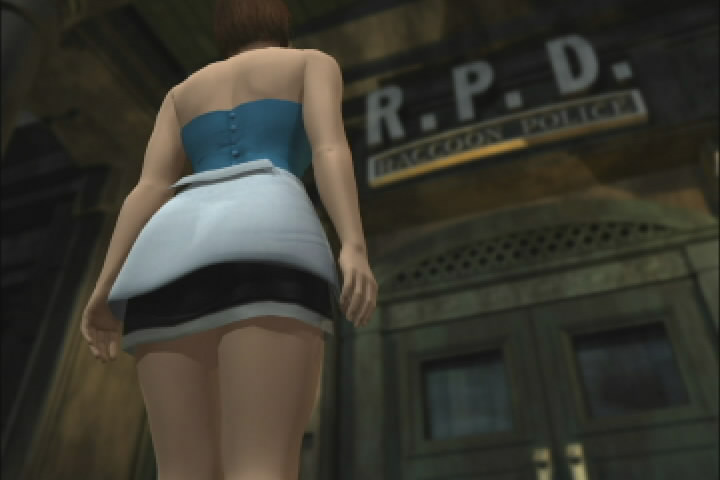
Sobre o Nemesis, ele é praticamente o único chefe do jogo inteiro. Qual foi o conceito por trás de sua criação, como perseguidor dos S.T.A.R.S.? Além disto, há uma história sobre o seu nome, que os japoneses não o chamam necessariamente de Nemesis. Pode nos contar mais sobre isto?
O nome dele também foi divulgado como sendo “Nemesis” no Japão, mas como nós desenvolvedores o chamávamos de “perseguidor” [Em japonês, “tsuisekisha”], aconteceu muito de as revistas da época publicarem esse nome. Acho que por isso passou a ser normal chamá-lo de perseguidor no Japão. Como comentei na primeira resposta, uma das ideias iniciais era tampar portas e janelas para impedir a invasão dos zumbis. Dentre esses conceitos, tinha um inimigo em estilo de ameba que conseguiria furar essas barreiras, invadindo a mansão por várias frestas. Ele é o conceito inicial do Nemesis.
Como era para ser um spin-off, nós precisávamos de uma nova temática para o terror – mas em cima desse conceito nasceu um novo tipo de terror que te perseguia por toda parte. Como com um personagem em formato de ameba a sensação que passava era de vários inimigos te atacando ao invés de perseguido por um só, mudamos o visual dele pra um personagem único e que chamasse a atenção. Daí nasceu o design atual do Nemesis.
Muitos fãs reclamam de inconsistências entre Resident Evil 2 e RE3 nos cenários do R.P.D., já que algumas portas e caminhos estão bloqueados em RE3, mas o caminho está livre em RE2. Por que a Capcom decidiu manter isto em RE3, em vez de só mostrar uma mensagem na tela ao checar estas portas, que levariam a locais não inclusos no jogo? Além disto, se a cidade estava em lei marcial e quarentena, como Claire e Leon conseguiram entrar em RE2?
Acho que essa é uma das “costuras” que eu mencionei na resposta 1. Na minha cabeça, é o seguinte: sobre portas e outros elementos bloqueados na delegacia, depois de Jill escapar dos arredores de lá, algum sobrevivente visitou o local. Essa pessoa fez uma busca por armas e comida e foi embora, mas esse sobrevivente foi atacado por um zumbi e virou um deles.
Leon S. Kennedy e Claire Redfield conseguiram entrar na cidade porque nessa hora, a guarda da cidade que estava cumprindo a lei marcial e impedindo pessoas de entrarem já haviam sido atacados por zumbis e morrido. Como não se fala isso dentro do jogo, não dá pra saber ao certo, né? Além disso, eu acredito que uma mensagem do tipo “você não pode passar daqui” (por conveniência do desenvolvedor) seria um insulto aos jogadores. Não importa a justificativa. Acho que não se deve colocar uma mensagem desse tipo.
Tem uma coisa que muitos fãs nos perguntam constantemente! Carlos Oliveira é brasileiro? De onde ele é, afinal? Pode esclarecer?
Mesmo sendo um cara de sangue nos olhos, ele é alegre e vive trocando piadas. É um parceiro perfeito para a Jill. Como ele tem uma cor da pele diferente de todos os outros personagens, decidimos que ele seria da América do Sul. Só não consigo lembrar se definimos onde ele nasceu; minha memória está um pouco confusa. Como eu e o Kawamura, que cuidava do roteiro, gostamos de MMA, batizamos os três mercenários com os nomes de três lutadores da época. Pegamos o nome do Carlos do Carlos Newton.
Que tipo de coisas foram planejadas, mas acabaram sendo removidas do jogo final? Como outros personagens icônicos aparecendo ou encontrando Jill, ou um protagonista diferente, inimigos diferentes etc.
Nós chegamos a desenvolver elementos como “atacar enquanto se move” e “barrar portas para impedir inimigos de invadirem”, mas como eles batiam contra os elementos do jogo atual, acabaram sendo cortados. Como originalmente ele era um spin-off de escopo pequeno, nós sempre estávamos enrolados com problemas de tempo de desenvolvimento e de pessoal, então conduzíamos a produção de modo que não tivesse nenhum desperdício. Acho que, na verdade, eram mais comum, durante o desenvolvimento, a gente criar uma folga e aí depois adicionar algo que queria fazer.
Como vocês imaginam, nós fizemos um planejamento inicial enorme com outros protagonistas fora os personagens clássicos e inimigos diferentes. Mas como estávamos limitados pelo hardware e os sistemas de jogo da época, se incluíssemos ainda mais do que ele já tinha, o foco da jogabilidade e do que queríamos mostrar ficaria ambíguo, e acho que o resultado seria decepcionante.
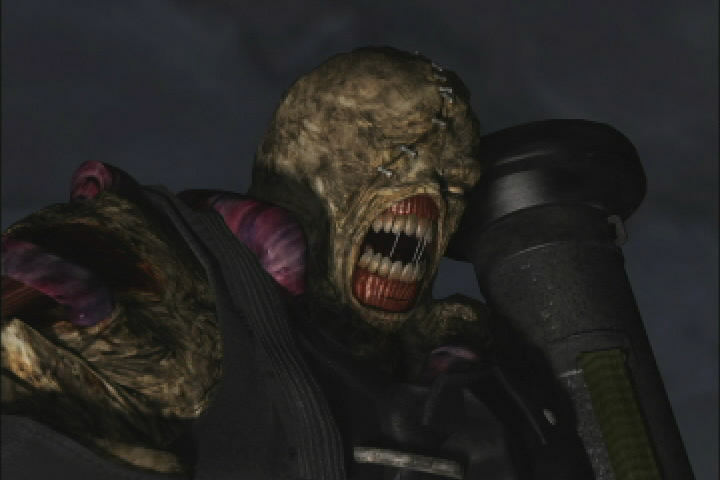
RE3 vai completar 20 anos, e as pessoas continuam encontrando coisas novas nele para aquecer a comunidade, como o pôster de Biohazard 4 no cinema, perto do restaurante, ou o DeLorean perto do posto de gasolina. Que outros easter eggs foram incluídos no jogo e podem ter passado despercebidos dos fãs?
É difícil de dizer, já que eu não sei até onde vocês descobriram. Mas há placas e pôsteres em lugares que não tem como examinar dentro do jogo, e nós pedimos para os designers criarem peças originais, escritas em inglês, para não violar os direitos autorais de ninguém. Vários deles têm palavras em inglês que correspondem a como se escreve os sobrenomes dos designers. Um exemplo é “BIG WEST” para “Oonishi” [lit. “Grande Oeste” em japonês]. E aparentemente também existe uma lápide com o meu nome espelhado – “AMAYOA ORIHUZAK”, para “AOYAMA KAZUHIRO”. Esse tipo de coisa nasceu do senso de humor dos designers, e outras brincadeiras ainda podem ter escapado da minha checagem. Se encontrarem, me digam por favor!
O que o senhor acha de pessoas dizendo que a história de RE3 deveria ser um DLC em RE2 Remake? Acredita que a história de RE3 possa ser considerada um conteúdo bônus de RE2, ou é uma história independente que deve ser levada em consideração de ter um Remake próprio?
Acho que tanto a equipe de desenvolvimento quanto os fãs ficariam felizes se a gente pudesse lançá-la como DLC de Resident Evil 2, se as pessoas quisessem jogá-la no sistema do RE 2 Remake. Por outro lado, acho que seria necessário esperar alguns anos se os fãs quisessem um remake de Resident Evil 3 feito de outra forma. Acredito que a Capcom tenha muitos planos, então vamos esperar eles anunciarem algo. Puxa, se fizerem um remake de Resident Evil 3, eu queria participar…
Então, o senhor trabalhou em jogos de Resident Evil anteriores, como o primeiro original e RE2, este segundo que acabou sendo refeito quando estava 70-80% pronto. Pode nos contar sobre sua experiência e sua opinião sobre o protótipo de RE2? Que tipos de grandes diferenças ele teria em comparação com o produto final, além de Elza Walker no lugar de Claire?
A história em que dois protagonistas chegam em Raccoon City e tentam escapar da cidade repleta de zumbis, ao mesmo tempo em que testemunham um pouco da tragédia da família William. Nesse eixo principal, não há diferença. As diferenças ficam na tragédia em si, e na forma em que a escrevemos e representamos. Além disso, existiam vários personagens (além dos mais importantes) fora os inimigos, armas para os jogadores, cenários e sistemas… Nós fomos ambiciosos, e criamos um jogo com muita variedade e profundidade.
Infelizmente, como é um jogo que nunca foi lançado, vou ter que manter os detalhes em segredo. Nós precisávamos estar em um nível de capacidade para conquistar vários elementos desafiadores, mas infelizmente não conseguimos chegar ao grau de perfeição que almejávamos.
E como foi a experiência com o produto final de RE2? É verdade que o senhor foi o responsável por criar o modo extra “The 4th Survivor” em Resident Evil 2? Então o Hunk foi planejado depois que a campanha principal estava pronta? Como surgiu a ideia e qual era o conceito inicial deste extra? A sua ideia original acabou se tornando a versão final ou foi modificada de alguma forma?
O Resident Evil 2 que existe hoje aprendeu com as falhas de que falei na resposta 9, então todo mundo no time de desenvolvimento criou uma visão mais clara do que queria fazer, e se focou em conseguir completar um conteúdo condensado. Do ponto de vista de um desenvolvedor, enfiar vários elementos te deixa mais tranquilo. Mas se eles não forem marcantes, ainda assim se torna um conteúdo fraco. Acho que o que nós aprendemos é que o jogo ganha mais força com um conteúdo forte e muito bem acabado e afiado, do que com vários menores. E isso nós colocamos em prática do desenvolvimento de Resident Evil 3 em diante.
No caso do Quarto Sobrevivente, nós pensamos em adicionar alguma coisa quando vimos que tínhamos tempo e energia sobrando. Eu trabalhei no equilíbrio de jogo em RE1 e RE2, e quando colocava os inimigos no mapa, fazia questão de posicioná-los de forma que fosse possível passar por eles sem levar nenhum dano.
Então, quando vi a equipe se divertindo durante os testes no meio do desenvolvimento, procurando por formas de passar sem levar dano, percebi que essa era outra forma de curtir o jogo. Aí eu sugeri um projeto de jogo focado nessa adrenalina de sair passando por tudo. Aí como o diretor Kamiya tinha gostado do soldado mascarado que era morto pelo G durante uma cutscene, decidimos que ele reviveria milagrosamente, e o seu objetivo seria levar o vírus de volta.
Fizemos um helicóptero que nem estava no planejamento de produção, e apesar de não termos tido tempo de incluir uma animação bacana para a fuga, lembro de ver a equipe se divertindo enquanto trabalhava nisso. Ele nasceu de uma ideia que veio do nada, e ninguém na época achava que faria tanto sucesso.

Até hoje, rola um debate na comunidade sobre o dia em que Raccoon explodiu. Fontes oficiais dizem que foi no dia 1º de Outubro, mas pessoas que estudam e analisam a série a fundo contestam que foi no dia 2. Afinal, em que dia Raccoon foi pelos ares?
Eu acredito que tenha sido em primeiro de outubro. Mas quando a cidade está explodindo no final de RE 3, a imagem que aparece é como se fosse o amanhecer do dia 2 de outubro. Então acho que a interpretação do dia 2 não está errada.
[Para encerrar] Um número incontável de jogos foi anunciado nesses quase 20 anos desde que Resident Evil 3 foi lançado. Mas independentemente disso eu me sinto muito orgulhoso do fato de que ainda existem fãs que jogam e se interessam tanto pela série Resident Evil quanto por Resident Evil 3. Muito obrigado. Acredito que no futuro poderei encontrar vocês novamente através dos jogos. Quando isso acontecer, vamos nos divertir e falar um montão de jogos!
Interview In English:
Aoyama-san, it is a great pleasure to have you here on Resident Evil Database. Can you please tell us a little about the pre-development process of RE3? What was the main concept of the game, in terms of fitting it in the series chronology?
[To begin with] The answers I gave in this interview are based on ideas from the time of the game’s development. So take things I say here as references to Resident Evil 3. Capcom owns Resident Evil 3. All the info the company publishes is the right one, there are elements she wants to keep in secret for a reason. I believe Capcom definitely makes these decisions to please the fans and make sure they have fun.
When development started, the game was not included in the Resident Evil series – it would be a spin-off, and the development time was short. At the beginning it was similar to the movie The Night Of The Living Dead: zombies would appear from all places, and the main character would run to a mansion looking for ways to escape and resist them. I remember I created a mechanic where the character would block doors and windows with a closet to avoid zombies from entering the mansion.
After one of two months, we tried to increase the general scale and turn it into a game where you would cooperate with other survivors to escape, both in that mansion and in the city, but because of the development time and the number of developers we had, we got stuck in a barrier: we could not produce a huge number of data.
So, just like in Day Of The Dead, we changed the theme to the story from a character escaping from an extinct city, and then we got the template for the actual Resident Evil 3, where Jill escapes from Raccoon City. Since the place would be Raccoon City and the character would be Jill, we could use the data from Resident Evil 2 to make things easier. But then come to us the need to solve how the story and the main concepts would be.
Since two months before the announcement it would be only a spin-off, not a properly numbered game, we did not worry too much about connecting these two elements and focused only in how to offer a very different game experience. I think that is the reason why these “issues” stand out.
Why was Jill Valentine, a S.T.A.R.S. member, the chosen one to be the main character of the game? Besides, why did Capcom choose her outfit to be a tank top and a skirt, since it it not functional in a survival situation and she should know that, since she is a soldier?
Since the basic concept would be a daily situation that turns upside down because of a disaster, we thought it would be better if she wore casual outfit, so she ended up getting a little sexier.
Perhaps it would have been interesting if the plot was a little different and the disaster would have happened in the middle of a wedding, to make it more dramatic. She could be using a wedding dress that would get stained with blood while they run desperately. The groom could even become a zombie in the middle of the run. It would be very dramatic…

Regarding Nemesis, he is basically the only boss in the whole game. What was the concept behind his creation, as S.T.A.R.S. stalker? Besides, there is the story about his name, that japanese people do not necessarily call him Nemesis. Can you tell us a little bit more about this?
His name was announced as “Nemesis” in Japan as well, but since we developers used to call him “pursuer” [in Japanese, “tsuisekisha”], many magazines at that time published that name. I think that is why it became a habit to call him “pursuer” in Japan. As I mentioned in the first question, one of the initial ideas was to block doors and windows to avoid the zombie invasion. Among these concepts, there was an amoeba-style enemy that would be able to break these barriers, invading the mansions though the holes. That was the initial concept for Nemesis.
Since it would be a spin-off game, we needed a new theme for horror – but from this concept a new type of horror was born, following you everywhere. Since the amoeba concept would look like many enemies attacking you instead of one, we changed his visual to a single character and a very eye-catching one. That is how the actual design of Nemesis was born.
Many fans complain from inconsistences between RE2 and RE3 scenarios in the R.P.D., since some doors and paths are blocked in RE3, but the path is free in RE2. Why did Capcom choose to keep that in RE3, instead of only displaying a message on the screen when you checked these doors that would take players to unexisting areas in the game? Besides, if the city was under martial law and quarantined, how did Claire and Leon managed to get there in RE2?
I think this is one of the “issues” I mentions in the answer 1. In my head, if happens like this: about doors and other places blocked in the police station, after Jill escapes from there, some survivor visited the place. This person made a search for weapons and food and left, but this survivor was attacked by a zombie and turn into one of them.
Leon and Claire managed to enter the city because at that time the city guard that was carrying out the martial law and impending people from entering the city have already been attacked by zombies and died. Since it is not said in the game itself, we cannot know for sure, right? Besides, I believe a message like “you cannot open here” (for convenience of the devs) would be an insult to the players. Whatever the explanation is, I do not think we should put a message like this.
There is something many fans asks us a lot! Is Carlos Oliveira from Brazil? Where is he from after all? Can you clarify this dilemma?
Even being a guy with blood in his eyes, he is vivid and is always making jokes. He is the perfect partner for Jill. Since he has a different skin tone from the other characters, we decided he would be from South America. I just cannot remember if we define where he was born; my memory is a little confused. Since me and Kawamura, the responsible for the plot, liked MMA a lot, we baptized the three mercenaries with names from three fighters from that time. We took the name Carlos from Carlos Newton.

What kinds of things have been planned, but ended up being removed from the final game? Such as other iconic characters showing up or meeting up with Jill, or any other different main character, different enemies etc.
We got to develop elements like “attack while moving” and “blocking doors to avoid enemies from invading”, mas since they would conflict with the elements of the actual game, they ended up being cancelled. Since originally it would be a spin-off in a small scale, we were always messed up with problems related to development time and staff, so we managed the production in a way we would not waste anything. I actually think, during development, that it was easier to create a gap and then add things we wanted in the middle of it.
As you can imagine, we initially made a huge planning with other main characters, as well as classic characters and different enemies. But since we were limited by hardware and game systems at that time, if we included even more things that we had, the focus on the gameplay versus what we wanted to feature would be ambiguous, and I think the result would be disappointing.
RE3 is almost 20 years and players still find new stuff on it to heat up the community, like the Biohazard 4 on the theater in the same street from the restaurant, or the DeLorean car next to the gas station. What other easter eggs have been included in the game and may have been not noticed by the fans?
It is hard to say since I am unable to know what you guys have already found out. But there are signs and posters in placed that cannot be examined in-game, and we asked the designers to create original plates, written in English, to avoid violating copyrights from anyone else. Many of them have words in English that make reference to the last names of the designers. One example is “BIG WEST” to “Oonishi”. And apparently there is also a tombstone with my name mirrored in it – “AMAYOA ORIHUZAK”, to “AOYAMA KAZUHIRO”. This kind of thing came from the sense of humor of the designers, and other jokes may have escaped from my checking. If you find them, please tell me!
What do you think about people saying the content of RE3 should be a DLC in RE2 Remake? Do you believe RE3’s plot could be considered as a bonus content for RE2, or it is indeed an independent story that should be taken in consideration and have its own Remake one day?
I think that both the development team and the fans would be happy if we could launch it as a DLC of Resident Evil 2, if people wanted to play it on the same system from RE2. On the other hand, I think it would be necessary to wait a few years if fans wanted a remake of Resident Evil 3 made in a different way. I believe Capcom has many plans, so let’s wait them announce something. Wow, if they are to make a Resident Evil 3 Remake, I would like to be part of it…
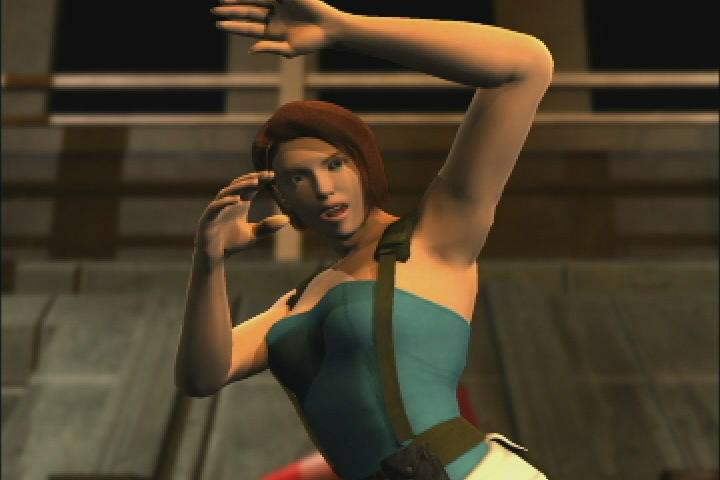
So you have worked on the previous Resident Evil games as well, such as the original first one and RE2, this last one being remake when it was 70-80% ready. Can you tell us about your experience and opinion on the RE2 prototype? What kinds of big differences would it have comparing to the final product, besides Elza Walker replacing Claire?
The story of two main characters getting to Raccoon City and trying to escape the city full of zombies, while witnessing the tragedy of William’s family. In this main arch, there were no differences. The differences were in the tragedy itself, and the way we wrote it and represented it. Besides that, there were several characters (aside the important ones) and enemies, weapons for the players, scenarios and systems… We were ambitious and created a game with a huge variety and depth. Unfortunately, since it is an unreleased game, I will have to keep the details in secret. We needed to be in a huge level of capacity to achieve many challenging elements, but sadly we could not get to the level of perfection we wanted.
And how was your experience with the final product of RE2? Is it true you were the responsible for creating the extra mode “The 4th Survivor” in Resident Evil 2? So HUNK was planned since the main campaign was ready? How did you come up with the idea and what was the initial concept of this extra mode? Did your original vision end up becoming the final version or was it modified as well?
The Resident Evil 2 that exists today learned with the errors I mentioned in the previous answer, so everyone on the development team created a clearer vision of what they wanted to do, and focused on the creation of a condensed content. From a developer’s point of view, adding too many elements makes it easier for you. But if they are not meaningful, it will still be a weak content. I think that we learned that the game gets stronger with a strong and refined content, instead of several minor others. And we put that into practice on the development from Resident Evil 3 onwards.
About the Fourth Survivor, we decided about adding something else when we saw we still had time and energy. I worked on the game balance for RE1 and RE2, and while adding the enemies in the map, my focus was to put them in a way it would be possible to pass through them without taking any damage.
So when I saw the team having fun on the tests in the middle of the development, looking for ways to progress without taking any damages, I realized that was another way to enjoy the game. So I suggested a game project focused on that adrenaline. Then since director Kamiya had really liked the masked soldier that got killed by the G on the cutscene, we decided to revive him with a miracle and his objective would be taking the virus back.
We added a helicopter that was not even there on the initial planning, and although we did not have the time to include a nice animation for his escape, I remember seeing the team having fun while working on it. He was born from an idea that come out of nowhere, and nobody at that time thought he would be such a success.
Until this day, there is a whole debate on the community about the day Raccoon exploded. The official sources say it was on the October 1st, but people that study the series say it was on the 2nd. So what is the right date of the explosion?
I believe it has been on the October 1st. But when the city is exploding in the ending of RE3, the image that appears looks like it is the dawn of October 2nd. So I think the interpretation of the 2nd is not wrong.
[To finish] A huge number of games have been announced on these almost 20 years since Resident Evil 3 was released. But independently, I feel very proud on the fact that there are still fans that play and have interest on the series as well as for Resident Evil 3. Thank you very much. I believe in the future I will be able to meet you guys again in the games. When it happens, we will have fun and talk a lot about games!











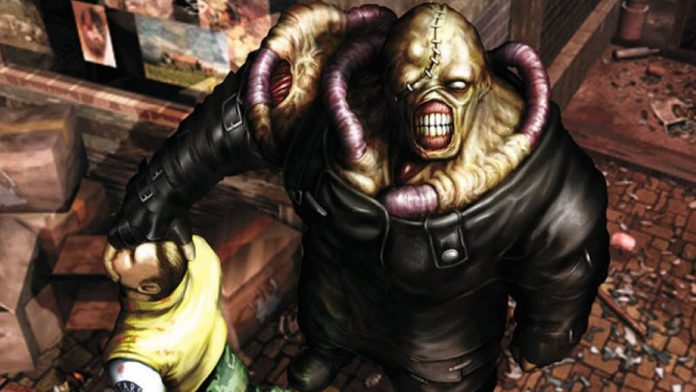

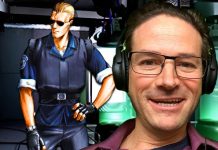





Amei!!!!
Incrível!!!!
Mas a resposta em relação a entrada da Claire e do Leon ainda não faz muito sentido mas enfim amei a entrevista!!!
Parabéns Moni ♥
No fim das contas não foi hoje que isso foi esclarecido para nós kkk (Nacionalidade do Carlos)
Ótima entrevista. Parabéns a todos os envolvidos
oiee
vim pelo mito caveira games
oiee
mo pirca na boca do menor
Parabéns pelo trabalho excelente!
Monique/Database Fazendo um trabalho magnífico. Ficou de mais a Intervista, olha parabéns… Muito bom mesmo. Parabéns!!!!!!
Amigo e nem vai … Sabemos que ele é da América do sul. E acho que vai ficar assim mesmo. Kkkkk onimporo imp e bquebpra nos ele sempre vai ser BR….b
Parabéns pela entrevista, ficou ótima!!
Entrevista incrível, realmente ficou sensacional. É sempre bom conhecer um pouco mais sobre o que há por trás do desenvolvimento dos jogos da franquia, principalmente de um jogo tão icônico igual ao RE3. Parabéns.
Sensacional. Sempre bom conhecer mais um pouco sobre a serie.
Muito boa a entrevista, e esclareceu muitas coisas.
muito bom, parabéns pela entrevista.
Incrível, Moni!
Muito simpático o Aoyama-san.
Espero mesmo que o desejo dele se concretize e ele faça parte do desenvolvimento do RE3 Remake. 😉
PARABÉNS!!! S2
Parabéns!
muito bom c:
Sensacionalllllllll
Muito obrigado.
Fazer entrevista com Aoyama é fácil, quero ver fazer com o Kamiya 👌😝👌
Muito boa entrevista, fico feliz em ver material brasileiro sendo desenvolvido!
Ótima entrevista!
Muito sem lógica o que ele falou naquela época não ligavam para detalhes
mas pense bem uma cidade em quarentena, duas pessoas entram os zumbis não podiam sair por aquele lugar e espalhar o vírus teria mais sentido começar o surto depois da chegada de claire e leon.
Comments are closed.